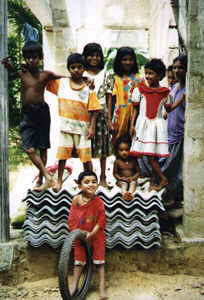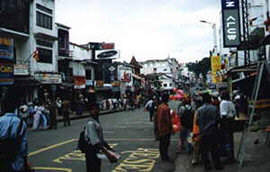 PEOPLE & LANGUAGE PEOPLE & LANGUAGE |

Sri Lanka's population is about 19 million; population growth is about 1.2% per year.
Population density is about 300 people per square meter, which makes it one of the most densely populated countries in South Asia. There are very few major cities within the Island. Colombo is the largest urban centre with an estimated population within 800,000 and 1 million. Other cities like Kandy, Negombo, and Dehiwala, have a population of around 100,000; this makes Sri Lanka mostly rural since only about 15% of the population lives in cities and urban centres.
 ETHNICITIES ETHNICITIES |
The biggest ethnic groups in Sri Lanka are the Sinhalese that account for 72% of the total population of the country. Sinhalese people divide themselves into two classes, the low country dwellers who inhabit the coastal towns and low lands and Kandyans, who live in the interior and in the hill country. Kandyan's consider themselves a step above the low country dwellers that live on the coastlines of the Island. Their pride is rooted in the fact that they were the last Sri Lankans to fight against and fall under British colonial power.

Tamils make up for another 18% of the total population. They are descendants of South Indian migrants who arrived in Sri Lanka about 2000 years ago by crossing Adams Bridge. They live mainly in the North and East part of the country, around Jaffna and the Port of Trincomalee. The civil war that has ravaged the country for the last 25 years is a result of the demands of some Tamils for an independent state that includes the North and South East part of the country.
| Another 6% of the population is considered Indian Tamils. This group differs from the other Tamils in the fact that they are descendants of workers brought in by the British to work in the Tea plantations of the hill country during 19th century.

Other ethnic groups include Arab descendants Moors and Muslims who are said to have arrived from the Gulf States around a thousand years back. There are also Malays who are descendants of the workers of the East Indies brought in by the Dutch and British.
This group accounts for 8% of the total population.
The Burghers are descendants of Christians from Portuguese and Dutch colonists
This group intermarried with Sinhalese, accounting for less than 1% population, most of them live in Colombo and within the Galle area.
 LANGUAGE LANGUAGE |
There are three main languages in Sri Lanka; these are Sinhala, Tamil and English. Language has been a conflicting issue in Sri Lanka. During the 1970's Sinhala was promoted as the sole official language of the country, which was seen by the Tamil minority as a way to keep Tamils from occupying government positions and pursuing higher education. Eventually Tamil and Sinhala were both made official languages to satisfy Tamil demands. English is widely spoken by almost all sections of society. Most of the people you encounter in shops hotels and resorts etc, will speak enough English to get anybody by. |

